Learning guitar chords can be an exciting journey, especially when you dive into the rich, jazzy sounds of the Cmaj7 chord. This guide will walk you through everything you need to know about the Cmaj7 guitar chord, from its definition to practical playing tips, variations, and more. Let’s get started!
What is a Cmaj7 Guitar Chord?
The Cmaj7 chord, also known as C Major 7, is a four-note chord that adds a subtle, jazzy flair to your music. It’s a major chord with an added major seventh interval, creating a sound that’s both uplifting and sophisticated. The notes in a Cmaj7 chord are:
- C (root)
- E (major third)
- G (perfect fifth)
- B (major seventh)
This chord is widely used in various music genres, including jazz, pop, and classical, due to its rich and full sound.
How to Play the Cmaj7 Guitar Chord
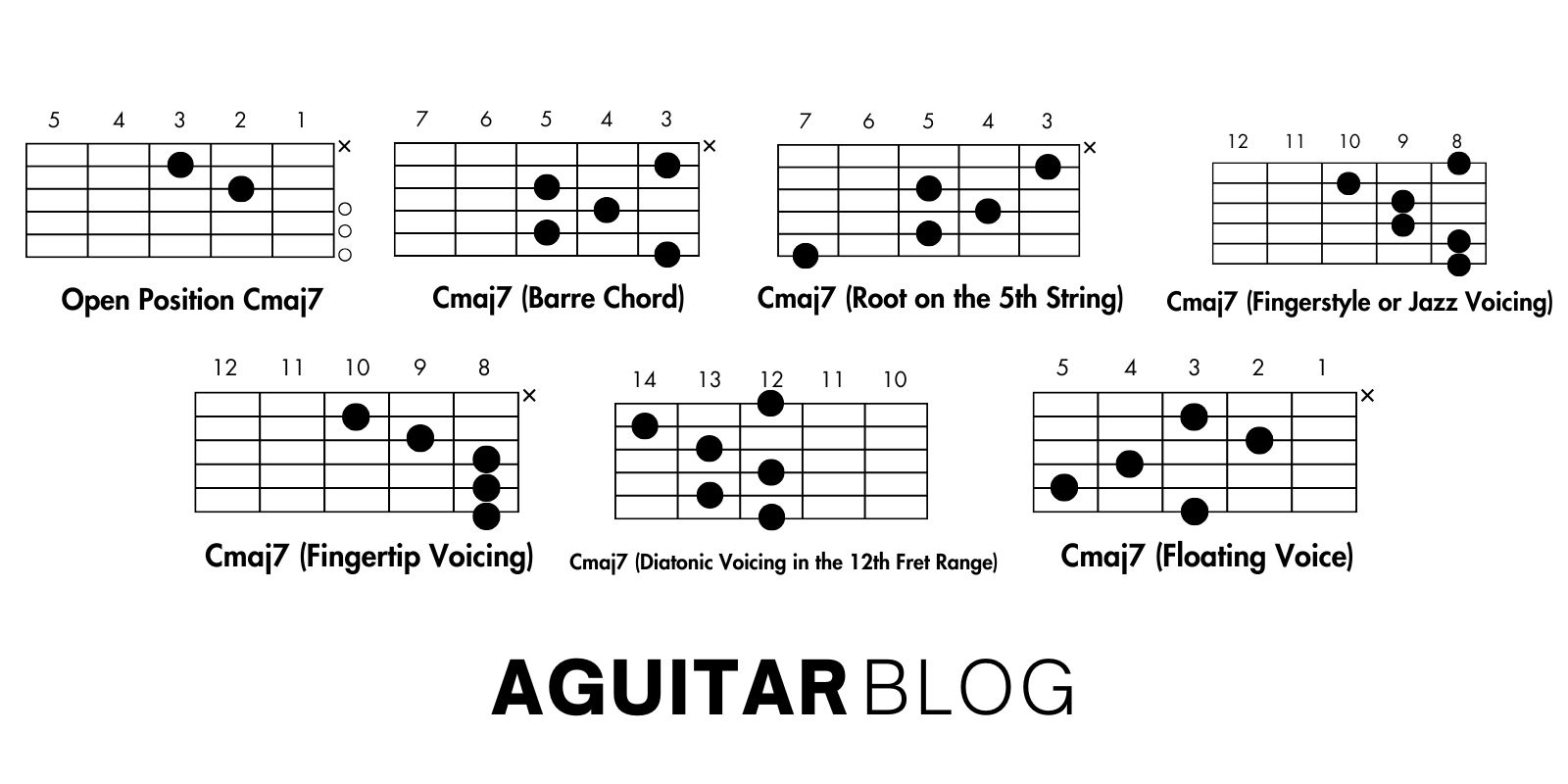
The Cmaj7 chord brings a smooth, dreamy vibe to your guitar playing, with its lush and sophisticated sound. Whether you’re strumming through a pop ballad or adding a jazzy touch to a melody, mastering this chord opens up new expressive possibilities. In this guide, we’ll show you how to play the Cmaj7 in different ways and explore its unique charm in various musical styles.
Open Position Cmaj7
The Cmaj7 in open position produces a warm, bright, and clear sound. It’s one of the most commonly used variations, offering a classic, soft, and romantic vibe. This voicing works well in many musical genres, providing a smooth, resolved tone.

How to Play:
- Place your ring finger on the 3rd fret of the A string (C note).
- Place your middle finger on the 2nd fret of the D string (E note).
- Play the G, B, and high E strings open.
- Don’t strum the low E string.
Cmaj7 (Barre Chord)
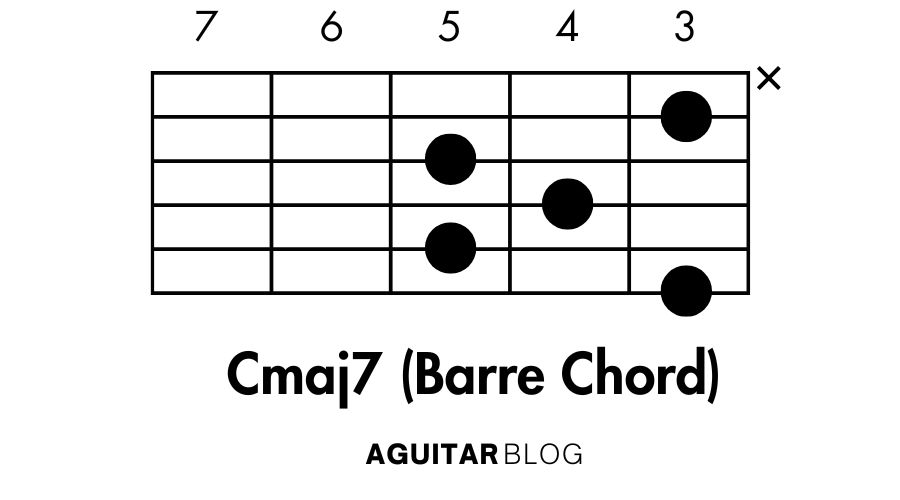
The barre chord version of Cmaj7 has a more powerful, full-bodied sound compared to the open position. It’s great for playing in more advanced progressions, offering a rich harmonic texture with more sustain.
How to Play:
- Barre your index finger across all strings at the 3rd fret.
- Place your ring finger on the 5th fret of the D string (E note).
- Place your middle finger on the 4th fret of the G string (B note).
- Let the other notes ring out for a full Cmaj7 sound.
Cmaj7 (Root on the 5th String)
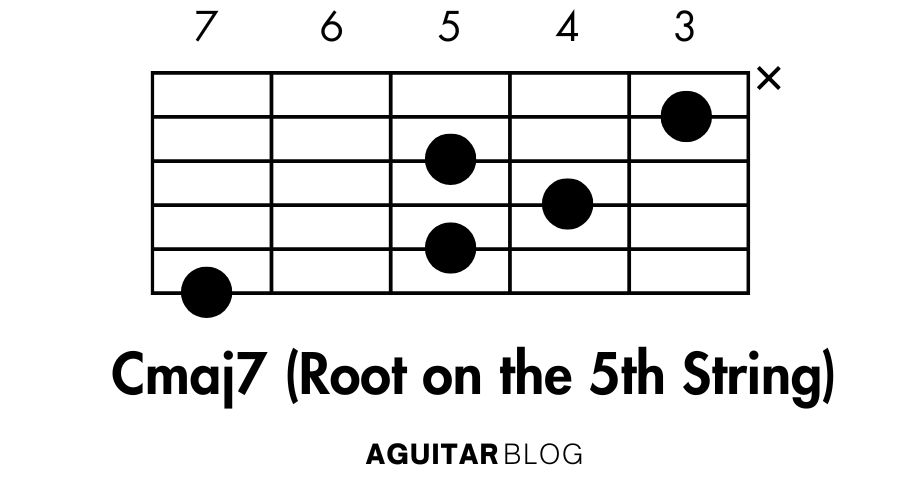
This voicing is a higher-pitched version of Cmaj7, emphasizing the harmonic richness of the major seventh. It has a smooth, almost ethereal quality, and is often used in jazz or more experimental styles.
How to Play:
- Barre your index finger across the 3rd fret of the A string.
- Place your ring finger on the 5th fret of the D string (G note).
- Place your middle finger on the 4th fret of the G string (E note).
- Place your pinky on the 7th fret of the B string (B note).
Cmaj7 (Fingerstyle or Jazz Voicing)
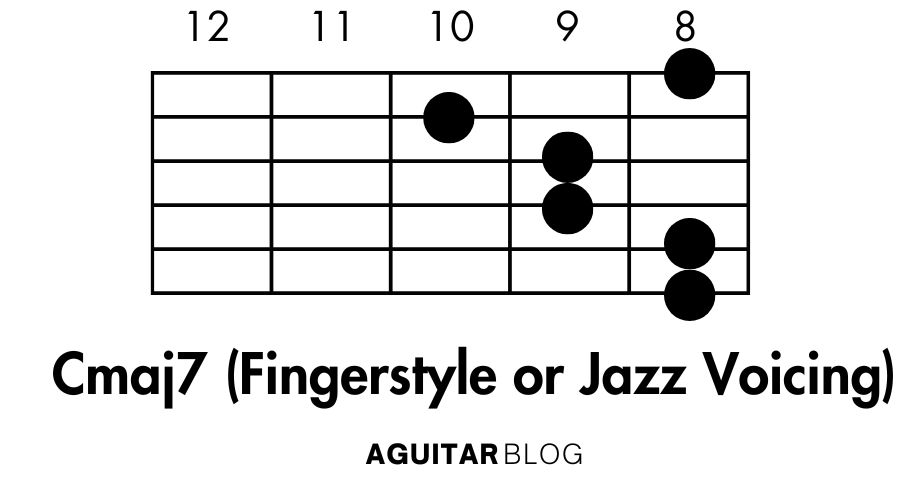
This voicing has a bright, lush sound that’s often used in jazz and fingerstyle guitar. The higher voicing makes it stand out more clearly in arrangements with multiple instruments, providing a more sophisticated harmonic feel.
How to Play:
- Place your index finger on the 8th fret of the low E string (C note).
- Place your ring finger on the 10th fret of the A string (E note).
- Place your middle finger on the 9th fret of the D string (G note).
- Place your index finger on the 9th fret of the G string (B note).
- Let the high E string ring open for a fuller sound.
Cmaj7 (Fingertip Voicing)
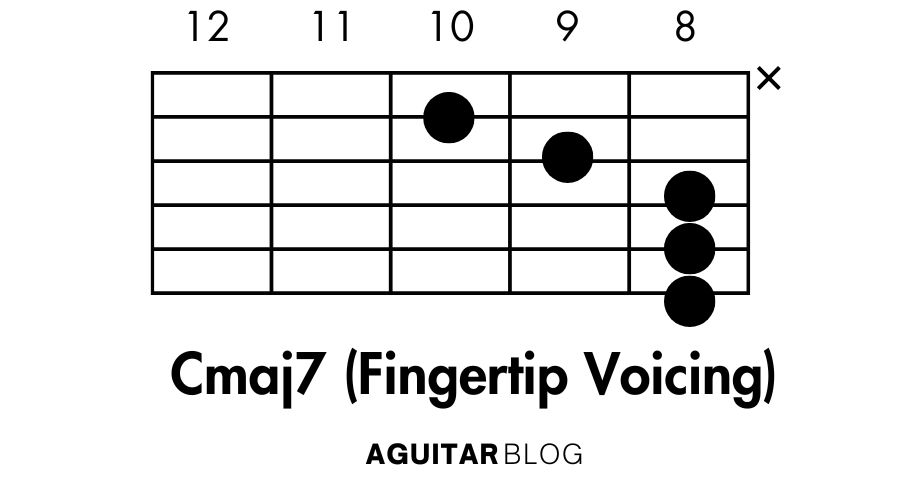
This version offers a very compact, clear, and smooth voicing of Cmaj7. It’s perfect for clean and defined notes, often used for subtle background playing in more intimate or solo arrangements.
How to Play:
- Place your index finger across all strings at the 8th fret.
- Place your middle finger on the 9th fret of the G string (E note).
- Place your ring finger on the 10th fret of the A string (C note).
- Let the rest of the notes ring out clearly for a soft, open sound.
Cmaj7 (Diatonic Voicing in the 12th Fret Range)
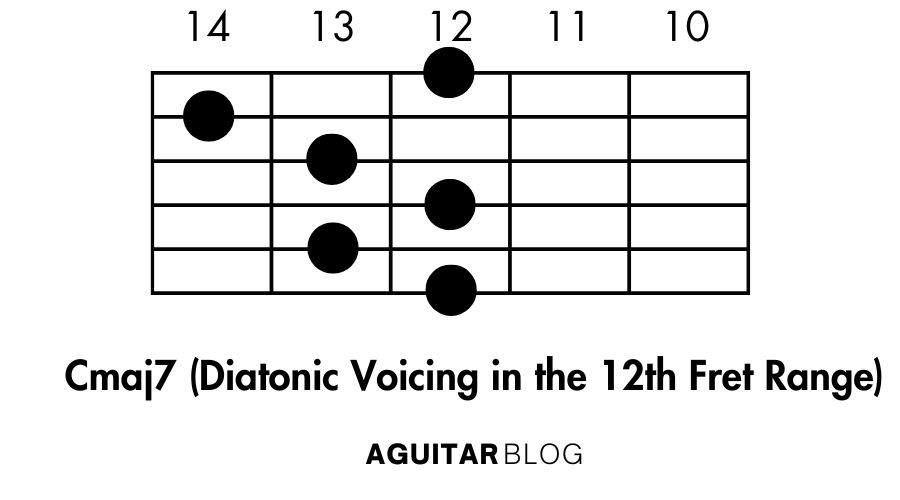
This voicing is in the higher registers of the fretboard, delivering a bright, sparkly tone with plenty of sustain. It’s ideal for solos or as a top melody note in full chordal arrangements.
How to Play:
- Place your index finger on the 12th fret of the low E string (C note).
- Place your middle finger on the 13th fret of the G string (E note).
- Place your ring finger on the 14th fret of the D string (G note).
- Place your pinky on the 12th fret of the high E string (B note).
Cmaj7 (Floating Voice)
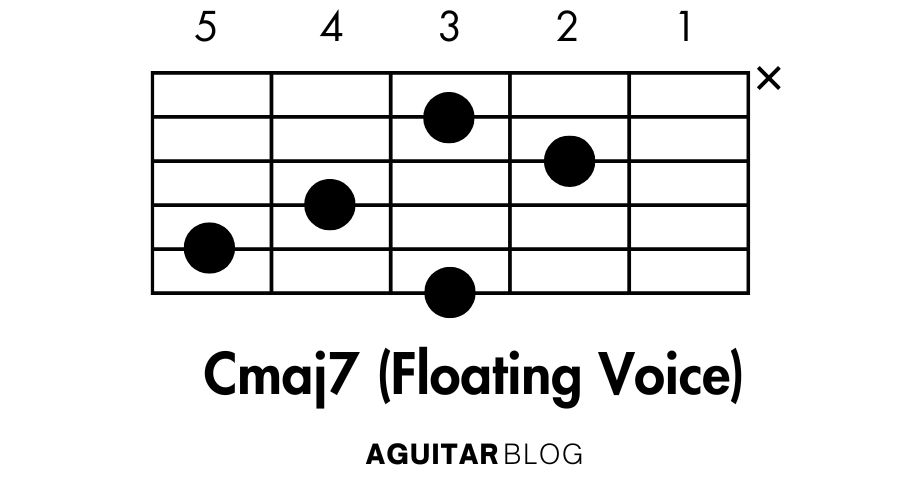
This voicing is more dissonant and adds a modern, almost unresolved quality to the Cmaj7 chord. Its use of wide intervals makes it great for creating atmospheric layers or intricate, harmonically complex passages.
How to Play:
- Place your index finger on the 3rd fret of the A string (C note).
- Place your middle finger on the 2nd fret of the D string (E note).
- Place your ring finger on the 4th fret of the G string (B note).
- Place your pinky on the 5th fret of the B string (G note).
Summary of Cmaj7 Chord Variations:
- Open Position Cmaj7 – A warm, classic voicing for beginners.
- Cmaj7 Barre Chord – A full-sounding version perfect for chord progressions.
- Cmaj7 (Root on the 5th String) – A higher-pitched, jazzier voicing for a sophisticated tone.
- Cmaj7 (Fingerstyle/Jazz Voicing) – Bright, lush, and ideal for jazz and fingerstyle players.
- Cmaj7 (Fingertip Voicing) – A compact, smooth version, perfect for subtle or intimate settings.
- Cmaj7 (Diatonic Voicing in the 12th Fret Range) – Sparkly and sustained for higher melodies or solos.
- Cmaj7 (Floating Voice) – A modern and dissonant voicing for atmospheric or experimental playing.
Top 5 Songs Featuring the Cmaj7 Guitar Chord
The Cmaj7 chord adds a rich, smooth quality to music, often used in genres like pop, rock, and jazz. These five songs showcase how the Cmaj7 creates an emotional, dreamy, and sophisticated atmosphere, enhancing the overall feel of each track. Whether you’re learning guitar or just enjoying the music, these songs are a great example of how the Cmaj7 can elevate a song’s mood.
“Something” by The Beatles
Key: C Major
Chord Progression:
In this iconic ballad, Cmaj7 is used as the first chord in the intro, followed by other variations of C and G chords. It continues to appear throughout the verses and adds a layer of smoothness and depth to the harmonic structure.
How It’s Used:
The Cmaj7 chord, with its serene and lush sound, creates a gentle introduction that perfectly complements the tender lyrics. The chord is played cleanly, letting its major seventh interval resonate and blend beautifully with the acoustic guitar, giving it a soft, almost nostalgic feel.
Why It’s Great:
The Cmaj7 adds a harmonic richness to the song, turning what could be a simple progression into something more complex and emotionally charged. It highlights the song’s themes of love and devotion, giving it a warm, heartwarming quality. The Cmaj7 makes the intro feel more expansive and sets the tone for the song’s reflective mood.
“I’m Yours” by Jason Mraz
Key: B Major (with Cmaj7 in the progression)
Chord Progression:
In this upbeat, feel-good song, Cmaj7 is part of the main chord progression in the intro and chorus, appearing alongside chords like G, Am, and F. The Cmaj7 appears in several key parts of the song, giving the entire piece a breezy, relaxed vibe.
How It’s Used:
The Cmaj7 is played in its open position form, creating a bright and open sound. It serves as the foundation for the harmonic flow of the song, and its clean, resonant tones create a sense of airiness that matches the song’s carefree nature. Jason Mraz’s smooth vocal delivery and relaxed guitar strumming make the Cmaj7 feel both effortless and uplifting.
Why It’s Great:
The Cmaj7 adds an element of simplicity and ease to the track, reinforcing the optimistic and positive mood of the song. Its soothing, bright sound is perfectly suited for the uplifting lyrics and overall light-hearted atmosphere. This chord enhances the accessibility of the song, making it feel like a fresh breath of air.
“God Only Knows” by The Beach Boys
Key: E Major (with Cmaj7 in the progression)
Chord Progression:
The Cmaj7 appears in the progression several times throughout this lush, multi-layered arrangement. It’s played as part of a larger set of chords that move through the song’s intricate, harmonically complex structure. The chord serves as a smooth transition between other major and minor chords.
How It’s Used:
The Cmaj7 chord is used to add a dreamy, floating quality to the song, creating a contrast against the more grounded, major chords in the progression. Its bright, rich sound fits perfectly with the song’s lush orchestration and layered harmonies. The Beach Boys’ signature vocal harmonies work in harmony with the Cmaj7, giving it an ethereal and uplifting character.
Why It’s Great:
The Cmaj7 enriches the song’s already complex harmonic structure, bringing an extra layer of sweetness and harmonic depth. It complements the emotional weight of the song’s lyrics and its romantic, hopeful theme. The chord helps create the feeling of vastness and openness in the music, giving it a timeless, celestial quality.
“Blue in Green” by Miles Davis (Jazz Standard)
Key: C Major (modal jazz)
Chord Progression:
The Cmaj7 chord is used in the modal jazz context of “Blue in Green”, where it serves as a primary harmonic center in the composition. The Cmaj7 appears in the opening and continues throughout the piece, interacting with other chords in a floating, less defined way compared to more traditional chord progressions.
How It’s Used:
In this jazz standard, the Cmaj7 acts as a foundation for the piece’s modal feel, providing a smooth, continuous backdrop that allows for improvisation and fluid melody. The tone of the Cmaj7 is reflective and calm, serving as an anchor for the improvisational lines that follow. The chord’s spacious, unresolved quality adds to the contemplative mood of the piece.
Why It’s Great:
The Cmaj7 is essential in this modal jazz context because it gives the song a calm, unhurried vibe that allows for expression and exploration. It’s not about tension and release but rather about the harmonic space the chord creates. The Cmaj7 contributes to the introspective, tranquil atmosphere, and its use throughout the piece emphasizes the free-flowing nature of jazz improvisation.
“Tears in Heaven” by Eric Clapton
Key: A Major (with Cmaj7 in the bridge)
Chord Progression:
The Cmaj7 appears in the bridge of “Tears in Heaven,” adding a moment of emotional depth to the song. The Cmaj7 moves smoothly through the progression, lending a bittersweet and reflective quality to the song’s overall tone.
How It’s Used:
The Cmaj7 is played cleanly, with its smooth, resonant tone giving the song a sense of longing and vulnerability. In the context of this deeply emotional ballad, the Cmaj7 enhances the reflective and somber mood, underscoring the personal grief expressed in the lyrics. Clapton’s fingerstyle playing and vocal delivery make the Cmaj7 feel both intimate and poignant.
Why It’s Great:
The Cmaj7 adds a layer of emotional complexity to the song, deepening its reflective tone. It helps convey the sadness and sorrow of the lyrics while also offering a sense of resolution and peace. In a song that grapples with the loss of a loved one, the Cmaj7 captures both the pain and the acceptance, making it one of the key harmonic moments in the song.
These songs demonstrate the Cmaj7 chord in different musical contexts—pop, jazz, and ballads. Each song highlights how the Cmaj7 can enhance a song’s emotional tone, whether it’s creating a dreamy atmosphere, adding harmonic complexity, or enriching a somber mood. Whether you’re strumming on an acoustic guitar or improvising in jazz, the Cmaj7 is a versatile chord that elevates the music in subtle yet impactful ways.
In conclusion, the Cmaj7 chord is a fantastic tool for adding depth and emotion to your guitar playing, whether you’re strumming or experimenting with more intricate voicings. By mastering this chord and exploring its many variations, you can bring a fresh, sophisticated sound to your music. Keep practicing, and don’t forget to check out more tips, tutorials, and chord breakdowns here at AGuitar Blog, your go-to resource for all things guitar!
SEE ALSO RELATED C CHORDS
